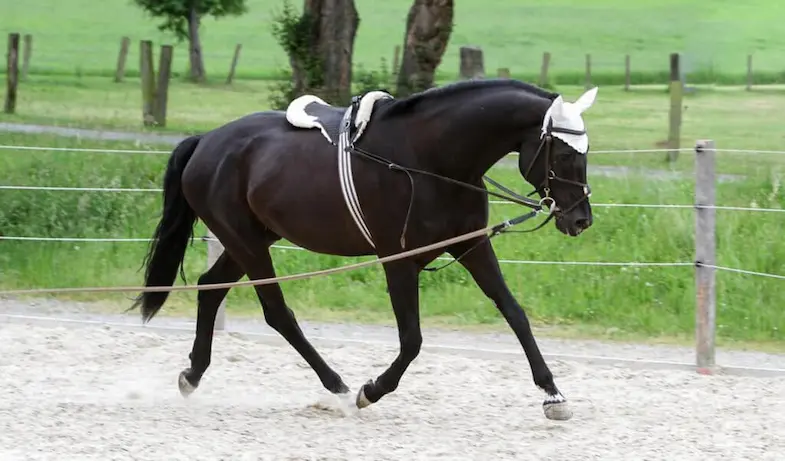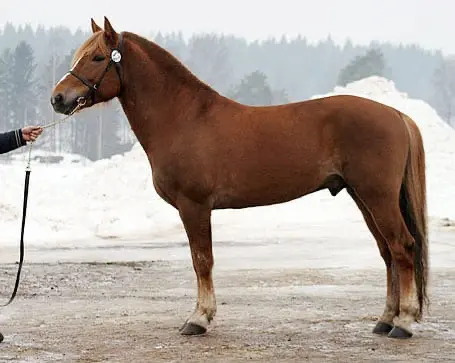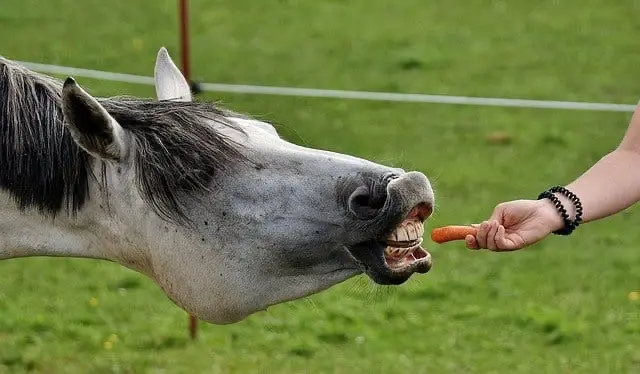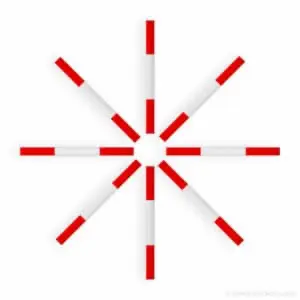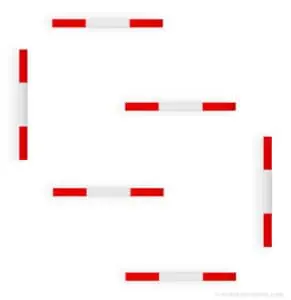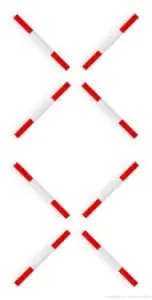Why is suppleness important in horses?
When we think about suppleness in horses it’s often linked to dressage horses (in part because suppleness is one of the key things horses are judged on) but it’s important for all horses regardless of discipline. Whether your horse is a record-breaking barrel racer, a quiet trail companion, or a retired eventer, suppleness is vital. Not only will it help them to move more freely it’ll also make their key joints (hocks, hips, knees, shoulders, poll, and jaw) more pliable it’ll and reduce stiffness in their whole body. If your horse is stiff and lopsided then, over time his muscles can waste which will not only increase their chance of damage but also the risk of joint problems such as arthritis.
How to tell if your horse is lacking suppleness
You know what it’s like when you wake up in the morning after having slept awkwardly, you find it difficult to move freely and with ease, and horses are no different in that respect. That said it can be difficult to recognize if your horse is supple (or notice a deterioration in his suppleness) when you ride every day but the best things to look out for are:
- Tension and resistance – Horses lacking suppleness will often be very tense and resistant to your commands when riding in a school.
- Easier on one rein – Horses are naturally more supple on one side because their muscles aren’t even lengths but if your horse isn’t supple this will be very evident.
- Is stiff and won’t relax – If your horse isn’t supple then he’ll automatically tense up and will be reluctant to soften up and bend his body.
Ground exercises to improve your horse’s suppleness and balance
There are many exercises you can do, both in and out of the saddle, to help improve your horse’s suppleness and balance but ground exercises are by far the best for improving his overall suppleness. If we’re being honest, it’s something that we’re all guilty of not doing enough, I know that when I’m pushed for time I tend to think ‘I’ll do it tomorrow‘, yet it’s our horses that benefit the most from doing this.
While the exercises below won’t take long, if done regularly, over time they’ll have a very positive effect on your horse, just don’t expect him to change overnight. Any muscle work (whether your toning, building, or in our case increasing their suppleness) takes time so don’t expect too much from your horse too soon. In time he’ll improve and you’ll notice a big difference, especially when you’re riding.
1) Stand square
This one of the most basic (and quickest) exercises you can do with your horse but it’s vital if you want to improve his suppleness, as an added bonus it’ll also help with his balance. The goal is simple, to have your horse standing square, naturally, and on his own without you helping him.
- Start by asking your horse to stand squarely and, if he’s not doing this move his legs (either by lifting them if he’s okay with that or nudging his legs) until he’s standing fully square.
- Hold that for a few seconds and then reward him by walking him forward a couple of steps.
- Repeat this regularly (around four or five times a week) and your horse will soon begin to loosen up.
2) Neck flexing
Once your horse is able to stand square without any input from you, you can begin to move on to flexing his head and neck.
- Begin by turning your horse’s head a little bit to one side.
- Place your hand on his upper neck, just behind his head, and turn it very slightly towards you (only turn it as far as is comfortable for him).
- Hold it for as long as is acceptable for your horse (but no more than 30 seconds) then repeat on the other side.
- Work your way down your horse’s neck (making sure you do both sides before moving on), holding it for up to 30 seconds each time.
- Again repeat this regularly.
3) Neck stretching
Some people call this exercise carrot stretching but the idea is simple and uses a carrot to get your horse to stretch his head and neck to reach (but not eat) the carrot – hence the carrot stretch name! When you first start your horse will want to eat the carrot immediately but you can use smaller treats to reward him when he doesn’t do this. Once your horse is stretching to get the carrot but isn’t eating it you can begin this exercise.
- Place the carrot so that your horse’s nose touches his chest.
- Next, move the carrot so that his head is in between his legs, at around the same level as his knees.
- Move the carrot so that your horse has to stretch enough for his nose to touch approximately six inches behind his front legs before repeating on the other side.
- Making sure your horse doesn’t move his feet place the carrot in front of him so that he has to stretch his head and neck as much as possible.
- Next move the carrot to the top of your horse’s shoulder so that your horse again has to bend his neck, repeat on the other side.
- Now move the carrot to where the hind legs meet the stomach and again repeat on the other side.
- Move the carrot so that your horse has to stretch towards his hind hocks, repeating on the other side.
- Lastly, give the carrot to your horse, he’s earned it and it’ll make it easier to repeat this exercise!
4) Back up
It’s not natural for horses to move backward (after all how often have you watched a herd of horses and seen one of them doing it?) but it backing up will not only help to improve their suppleness but will also help you while out riding, especially if you need to open a gate. If your horse is stiff then he’ll have trouble doing this, to begin with, and will probably start to twist his body and raise his head. Don’t worry this is normal and the more you do this exercise the less your horse will twist.
- Start by holding the lead line in your hand and, facing your horse, apply a little bit of pressure until your horse starts to walk backward.
- As soon as your horse takes a few steps backward release the tension on the lead line and walk him forwards to take the pressure off of his body.
- Repeat this regularly, asking your horse to move back a few more steps every time.
- Once your horse is able to do this easily you can start to ask him to lower and raise his head at the said time. This requires him to fully stretch his whole body from his poll, through his topline, and down to his hindquarters.
TIP: If you have trouble keeping your horse straight (either because he has trouble moving in a straight line or you can’t keep him straight) then simply place two poles approximately 1 to 2 meters apart and guide him between the poles.
5) Clockwork poles
Working within a circle is great for all horses regardless of their ability or level of fitness, it encourages the horse to relax his entire body (from his jaw, neck, and shoulders through his back and down to his hindquarters) which will, in turn, improve his suppleness and flexibility.
- Start by laying eight poles in a radiating circle, like a clock (so the poles are at 12 o’clock, 1:30, 3:00, 4:30, 6:00, 7:30, 9:00, and 10:30).
- Stand in the center of the circle and ask your horse to walk, in a circle, over the poles at a distance that is comfortable to him. At first, one side will be easier than the other so start with your horse going in that direction.
- Walk your horse round in the same direction for between five and ten minutes before changing direction and repeating for the same amount of time.
- As your horse’s suppleness improves you can start to gradually increase and reduce the size of the circle as your horse walks round. This helps with your horse’s balance and bend too because he’ll need to adjust it as the circle’s diameter changes.
- Like most of these exercises, you should repeat this a few times every week.
6) Weaving poles
Part of improving your horse’s suppleness is to encourage flexion and this exercise is perfect for that because your horse will have to make plenty of turns while doing this.
- Place six poles on the ground in the layout shown, making sure there are at least 2 meters between the poles.
- Start at either the top right or the bottom left, depending on which direction is easiest for your horse, and walk him in between the poles.
- As your horse improves you can reduce the gaps between the poles so that he has to turn tighter.
7) Crisscross poles
While this exercise might seem simple and straightforward, the movements your horse will be making will have a big impact, not only on his suppleness but also on his core. The more you do this the better he’ll become and you can take it up a notch by asking him to perform the exercise at a trot.
- Lay the poles out in an ‘X’, making sure they don’t touch (you can use either four poles or eight to create two stacked X’s).
- To start with walk your horse over the poles, making a left turn before going over the next pole.
- If you’re using eight then instead of turning after the second pole continue in a straight line to the one in front of you before turning left and going over the next one.
- Repeat this three times then change the direction and repeat three times.
If you’re comfortable lunging your horse then, use four poles and have him perform a circle over them.
8) Irregular poles
Pole work is fantastic for helping your horse’s suppleness and balance but irregular pole work will strengthen his muscles (and improve his concentration) at the same time. To do this properly your horse will need to think for himself (rather than pick up on cues from you) so it should only be done while lunging. It can be done either with the poles in a straight line or in a circle but doing both will have the biggest impact on your horse.
This can be done with any of the exercises above but instead of spacing the poles evenly apart randomize a few of the gaps. This will force your horse to pay attention to what he’s doing as well as to every stride he takes. As your horse advances you can increase the number of random gaps and even introduce some raised poles to the exercise. If you do raise some of the poles don’t raise them above 1ft (0.3 meters) and don’t allow your horse to jump them.
I hope you found this article helpful. If you did I’d be grateful if you could share it please as it would really help me.
Recommended products
Over the years I have tried hundreds of different horsey products, from various blankets and halters to different treats. Some I’ve loved, others I’ve hated but I thought I’d share with you my top all-time favorite products, the ones I never leave the yard without. I’ve included links to the products (which are in no particular order) that I really think are great.
- Horse Knots by Reference Ready – If you’re like me and enjoy pocket reference guides then you’ll love this knot tying guide. These handy cards can easily fit in your pocket or attach to the saddle for quick reference. They’re waterproof, durable and are color coded to make them easy to follow.
- Mane ’n Tail Detangler – Even if you never show your horse you’ll need to detangle his tail from time to time (and possibly his mane too) which is always a challenging chore! I’ve found that if I run a little bit of detangler through my horse’s tails every few days it stops them from getting matted up and makes combing them easy, even if they’re coated in mud. I don’t know if I should admit to this or not but it also works wonders on my hair.
- TAKEKIT Pro clippers – Over the years I’ve tried a lot of different clippers and while some were obviously better than others I found these to be by far the best. They are heavier than a lot of other clippers but for me, that’s a good thing, it makes them feel more sturdy and hardwearing. On top of that they have a range of speeds so are just as good for clipping your horse’s back as they are his face. I also like the fact that they come in a handy carry case but that’s not for everybody. The company that makes them is super good and incredibly helpful too, a real bonus these days. The only thing I wasn’t keen on was the fact that it doesn’t come with any oil, but that’s not a major problem as it’s not difficult to buy lubricant.
- Shire’s ball feeder – There are so many boredom buster toys out there but I like to use these every day, regardless of whether or not my horses are bored. I find that it helps to encourage my horses to problem solve by rewarding them with treats (or pieces of fruit) but it also mimics their natural grazing behavior which helps to keep them calm and de-stressed.
- Horse safe mirror – This is a strange one that many people are surprised about but I like to put horse safe mirrors in the trailers as well as in the quarantine stalls. It helps to prevent the feeling of isolation by giving the impression of other horses being around. Being herd animals horses can get extremely stressed when they feel that they’re on their own but with these stick-on mirrors, they believe that at least one other horse is with them.
- Rectal thermometer – I know this isn’t glamourous at all but it’s vital for your horse’s well-being to be able to check their temperature and a rectal thermometer is the easiest way of doing this which is why I’ve added it to the list.
Shopping lists
I’ve also put together a few shopping lists of essential items that I’ve found helpful over the years. I’ve broken the lists down into different categories rather than put everything in one massive list 😉

